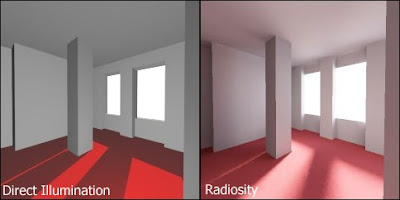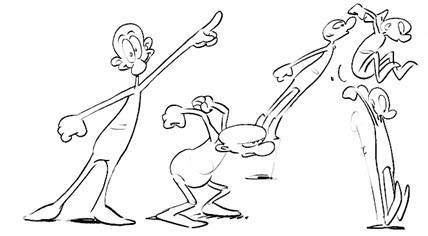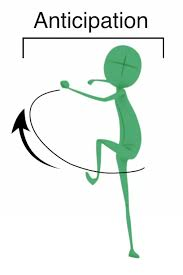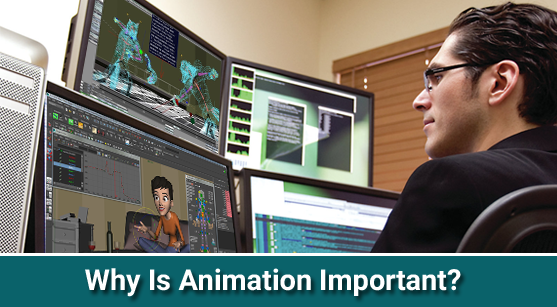This is the first in a 5 part collection of animation
phrases which are vital to realize.
In this listing of terms I consist of the most common
animation terms which you are possibly to listen and use in an animation
studio. Many of those phrases also are standard film terms as properly.
(image : google)
Action as Dialogue – When a person does something, in place
of replying to a question, announcement or movement of another person; it
serves as the equivalent to an real response.
ADR – Additional Dialogue Recording; lines of discussion
which can be revised and re-recorded at some point of Post-production.
Alpha Channel – The part of a virtual picture that is
transparent.
Animation – Frame by using frame movie making.
Animating on 1’s/2’s/3’s and many others. – How long every
drawing (or body) is held throughout playback. Most usually, animation is
performed returned on 2’s for a smooth appearance.
Appeal – The common quality or charm of any animation.
Aspect Ratio – The ratio of peak to width of the frame
expressed as a ratio (eg. Four:three, or 16:9) For a popular (rectangular) TV
image – for each four devices huge the image is 3 units excessive. And for a
more moderen HD TV (rectangle) image – for each 16 units extensive the picture
is nine devices excessive.
Background – Usually known as a “BG”.
The static elements in a scene that seem to lie on the most distant aircraft.
The BG is typically rendered on a single stage as a portray.
Balance – The design aesthetic this is taken into
consideration while visible factors are added , deleted, located and scaled in
the numerous stages of the animation process.
Birds Eye View – An extraordinarily excessive camera
position and down shot.
Blocking – Rough animation with none refining. An try to
show difficult timing and posing.
Breakdown Pose – There are Key Poses and Inbetweens, however
a breakdown pose is like a unique key pose that enables to define a certain
movement between pose A and pose B. Usually to help outline an arcing motion.
Camera Angle – The height and angle wherein the digital
camera is pointing. In an animation studio we use different phrases to explain
normally used camera angles together with Upshot, Down shot, Birds eye view,
Worms Eye View, Medium Shot, Head Shot, Wide Shot, Establishing Shot, Two shot,
Close up, Extreme Close Up.
Camera Move – Any change inside the fielding of a scene, or
any time the digicam actually actions (in preference to panning a background).
A digicam pass can be a Zoom, Truck In, Truck Out, Rotation, Tilt, and so
forth.
Camera View – The paintings that appears inside the cameras
discipline of view; That a good way to be rendered.
Cheat – Repositioning of elements in a scene so that you can
beautify the visible effect or enchantment of its composition. Anytime some
thing isn’t working in a scene and we've to break the guidelines or do
something unconventional we typically call it a “cheat” – “allow’s cheat this”
or “lets do a cheat”.
Close-Up – A shot wherein the camera is framing the item of
hobby simplest, generally the pinnacle and shoulders on the case of a man or
woman.
Color Model – The first digitized drawing of a person to be
painted. It serves as a prototype for all of the next drawings of the identical
person. Often the BG is cited so one can choose hues so one can have
enchantment in the very last composited version.
Compositing – Done in software program. The combining of two
or more separate factors into one. For instance – compositing the character,
history, and foreground factors collectively. Alpha channels and layers are
used.
Composition – Balancing the tremendous and negative spaces
in a scene, in addition to the angles and shapes of elements to direct the
viewers eye to the focus of the action. Also, to create a nice or appealing
arrangement of the elements in a scene.
Compression – Method of decreasing the document length of a
virtual image. Software will calculate those regions in which the RGB values of
the photograph are comparable (eg. Big areas of flat coloration in the BG
including a sky) that may be grouped together in preference to rendered as
separate pixels.
Constant – Part of any motion where an gadgets pace is
regular from body to border.
Cross Cutting – The technique of inter-cutting photographs
from separate, parallel movement sequences in a story.
Cross-Dissolve – Sometimes, known as a Dissolve or
X-Dissolve. A transitional device wherein an outgoing scene fades out at the
same time as the following scene fades up over the same range of frames.
Cut – A exchange of scenes without any form of transition.
E.G. “reduce to the following scene”.
Cutoff – Usually referring to TV Cutoff. The place of the
recorded picture which is assured to be in the viewing area of a preferred
video display.
Cycle – A series of drawings or key poses which are designed
to hook-up and be repeated as usually as required.
Dailies – Sometimes known as Rushes. The screening of all
takes and pictures produced the previous day. Usually for reviewing by means of
a Lead Animator, Animation Supervisor or Director.
Dialogue – The voice recording written and created earlier
of the characters Lip-sync being animated.
Dubbing – The moving of a video-photo, sound or each, from
one format to every other, typically to make copies from a “Dubbing Master”
videotape.
Editing – The arrangement of scenes right into a final
episode or movie manufacturing complete with all sound factors, transitions,
effects, and titles.
Effects – Also called EFX, FX, or Special Effects. Any
animation which is not a man or woman or prop consisting of smoke, fire, water,
explosions, mild fx and so forth.
Establishing Shot – A huge shot to establish the area of
wherein the action is ready to take location.
Exaggeration – Overdoing or pushing the characters movements
to exploit it’s comedic attraction.
Extreme Close-up – Very tight camera framing in which
simplest a part of an item or character is in view.
Extreme Keys – Also known as “Extremes”. Those key-frames
that are taken into consideration critical so that you can explicit the motion,
usually while a trade of direction takes place.
Fade In/Fade Out – An adjustment in exposure over a series
of frames to be able to brighten the image from black (fade in) or darken the
photograph (fade out).
Field – In animation, it’s the location within the view of
the camera.
Field Guide – Frame lines indicating the favored framing of
a scene. It’s essentially a container which you preserve your animation inside
of. These days you normally have a field guide that suggests a four:three
aspect ratio for older TV presentations and a 16:nine ratio for wider HD
presentations.
Flash Back/Flash Forward – A deliberate leap within the term
of a movie designed to present the target audience extra information
approximately what befell at that factor in time.
Flash-reduce – Sometimes referred to as a Flutter-cut. A
series of quick cuts, usually between two distinct scenes that create a sense
of frenzy and anxiety.
Flow Chart – Also referred to as a Production Chart. A photo
representation of the essential timeline essential to meet a production
deadline.
Footage – Final entire animation that can be added to the
next manufacturing degree.
Foreground – The factors in the frame which seem closest to
digicam.
Frame – A unmarried rendered or recorded picture.
Frames Per Second – Referred to as F.P.S. – The rate at
which photographs need to be displayed with a view to gain real time playback.
(generally 24 FPS for film and 30 FPS for video).
Frame, Framing – Composition of a scene may take the shape
of Tight Framing or Loose Framing.
Gag – A funny movement. A gag is like a visible funny story
– there may be a fixed-up and a pay-off.
Gesture – A characters pose or a subtle motion that invokes
a narrative or a gets throughout an concept. For instance, a man or woman with
her hands on her hips makes use of her head to gesture in the direction of the
door.
Gesture Drawing – Life drawing designed to correctly capture
a fashions motion with a minimum quantity of line paintings, detail and
rendering.
Head – The beginning of a film, collection or scene.
High Angle Shot – Also called a Down Shot. Achieved with the
aid of setting the camera excessive above the elements of a scene, searching
down on the motion.
Hold – A range of frames wherein the movement is static and
a individual remains within the same function (also see Moving Hold).
Illusory Time – Also known as Conditional Time. A depiction
of activities this is subjective and designed to convey a characters notion of
the passage of time (eg. Dream Sequence).
Inbetween – Those poses that arise among the the primary
Animation Key Poses. In classical animation, those are the animated drawings
created by using an Inbetweener. This position hardly ever exists in manufacturing
any more as maximum animation software program will help animators in this
undertaking.
Jump Cut – A soar within the spacial and temporal continuity
of a scene;typically a mistake, the result of a lack of “insurance” or no
longer enough heritage space. It may be used deliberately for its jarring
effect. (eg. Jean-Luc Godards’ Breathless).
Key Poses – The strong poses of a character that expresses
the vast movement of a scene. Used for man or woman appearing.
Layout – The stage in manufacturing between Design and
Animation. The Layout Artist creates a Field Guide, Levels for all scene
factors, brings within the Props, FX, and BG as well as the start poses for the
characters in the scene. The reason of this stage is to set up the scene for
animation.
Limited Animation – Pose-To-Pose animation with the least
quantity of inbetweens used. Actions are commonly brief and preserve for longer
intervals of time throughout speak.
Lieca Reel – Sometimes called an Animatic. Basically a
transferring storyboard with sound. The Lieca is a part of pre-manufacturing –
Storyboard panels are scanned and cut collectively to length and with talk.
This is accomplished in an modifying suite by using an editor and accompanied
through the director. This technique is meant to lock down the pacing of the
show or animation piece. A movie file is created and dispensed to the
production groups to observe, get a experience for the what the director is
looking for and use as reference.
Lip Sync – The animation of a characters mouth to suit the
recorded communicate supplied. Some productions have a lip sync artist who
specializes in this. In different productions the animator is chargeable for
the lip sync.
Low Angle Shot – A digicam attitude wherein its placement is
lower to the ground than regular eye stage.
Match Dissolve – A Cross Dissolve in which the composition
and situation rely fit visually.
Match Cut – A cut wherein the composition and challenge
count suit visually.
Medium Shot – Camera framing in which characters are framed
about from the waist up.
Mix – Also referred to as Sound Mix. The session in which
all of the sound tracks are adjusted and then combined in order to blend with
the visuals.
Motion Capture – Sometimes referred to as Mocap. The digital
recording of spatial and kinetic statistics with the aid of sensors worn by
means of an actor or athlete who plays an movement to be represented in 3-d
Animation. Used nearly solely in gaming. There is another extra superior
technique referred to as overall performance seize which additionally records
facial actions used for film and video. It became first developed and used for
the film The Polar Express starring Tom Hanks.
Moving Hold – A series of frames in which a man or woman is
distinctly motionless. Usually there is a very subtle motion to maintain the
individual “alive”, which includes blinks and changes in eye direction.
Outtakes – Footage not used in the final assembly of a
chain.
Over-Shoulder-Shot – A two shot wherein the lower back of
one of the characters heads occupies the foreground.
Pacing – The rhythm of a chain, scene or whole movie. The
pace a which moves occur.
Pan – A camera circulate wherein the camera actions
alongside its horizontal axis; pans to the proper or left.
Pantomime – A dramatic enjoyment, originating in Roman mime,
in which performers specific that means via gestures now and again observed
with the aid of tune. It’s important for individual animators to have an
excellent information of pantomime to efficaciously bring a characters moves to
an target audience whilst there is no dialogue.
Pass – A run-through of a whole sequence or section of
animation even as interest is given to one unique detail of the animation.
(e.G. Doing a pass for facial animation, or a skip for secondary animation).
Persistence of Vision – The belongings in human vision that
lets in us to understand hastily displayed sequential pictures as easy
movement, the edge of which takes place at approximately 18 FPS.(frames
consistent with 2nd).
Point of View – Also known as P.O.V. – A digital camera
angle that approximates what one of the individual in a scene would be seeing.
Pose-To-Pose-Animation – The method of animating in which
intense poses of the man or woman are created inside the desired order, then
the in betweens are finished to create smooth movement. May also talk over with
Limited Animation wherein few in betweens are employed. (also see Straight
Ahead Animation).
Post-Sync – Dialogue this is delivered to a scene after it's
been lively.
Production Management System – Every manufacturing studio
has the sort of. A web based system orÂ
software that enables music the development of a studios productions.
Shows the development of any given scene, stats for the percentage completed in
each stage of production, and different tracking records in order that it may
be measured against the predetermined schedule. Everyone inside the studio uses
the PMS to understand the development of all aspects of the production and to
help live heading in the right direction with time limits.
Read – To appear surely, as in characters motion “reads”
properly.
Reaction Shot – A shot of a person reacting to something on
or off display. It can be a response to spoken speak or something sincerely. A
reaction shot usually cuts in towards the person in a near or digicam attitude.
Retake – A scene that has been checked by way of a Lead
Animator, Animation Supervisor or Director and is sent lower back to the
animator for fixes or modifications.
Character Rotation – Model Sheets, a part of a Characters
Design Package indicating Front, Side, Back, 3/four, and three/four returned
perspectives. (and on occasion 3/8 views as nicely).
Rotoscope – The tracing of movie from stay movement
pictures, occasionally the entire of the live movement photograph and now and
again most effective points to fit registration within the animation.
Rough-cut – A first edit, the meeting of footage that serves
as a primary try to finalize shot choice and trims of scenes.
Scenario – The first draft of a story outlining the plot,
commonly in one web page.
Scene – A segment of animation from one reduce to the
subsequent reduce (acknowledged in stay movement as a shot).
Sequence – A series of Scenes, generally taking place at one
time and region managing the development of a single, principal plot point.
Split Screen – Multiple pictures that appear on screen on
the same time.
Staging – The positioning of all factors in a scene so the
movement can be honestly represented. Usually performed via Layout however
additionally paid interest to and frequently subtle by way of Animators.
Stock Shots/Stock Footage – Parts of an animation that may
be re-used as often as needed. Often utilized in Series Animation while the
same motion happens in each episode, at a particular component within the tale.
Storyboard – A collection of hand drawn panels that convey
the composition, digicam perspective, and poses of the characters in all of the
sequences or scenes of an lively manufacturing. Animators use it as form of a
blueprint to plot the characters timing and posing in their scenes.
Straight Ahead Animation – The Animation approach employed
while the concern is the manner wherein something animates instead of hitting
particular key positions (or talk accents), used regularly in fx which include
smoke and water splashes.
Sync – Short for Synchronization, meaning that it's miles
strolling in unison with or at the same pace. This is vital for sound elements
that have to run on the equal velocity when the film is projected for you to be
synced as much as the visuals.
Stop Motion Animation – Frame by means of frame movie making
using small scale sensible units, props and real lighting fixtures.
Tail – The end of a scene, sequence or movie.
Take – Footage this is generated for any scene. Any try to
create very last factors for a scene.
Taper – Also known as Taper or Ease. To sluggish or ease out
of a motion.
Thumbnails – Small drawings or rendered photos used to
express an concept for making plans.
Tilt Shot – Also called Dutch Tilt. A shot in which the
digital camera has been turned around along the Z axis. (tilted)
Time Code – The numeric show that corresponds to the going
for walks time in video, normally digits
each for the hour/minute/2d/frame. (eg. 00:22:02:29)
Tracking Shot – A shot where the digicam moves, just like a
Dolly Shot but where a constant distance from the difficulty is maintained,
following the action.
Truck-in/Truck-out – Also referred to as Push-in/Push-out.
An adjustment inside the cameras framing that lets in the view to tighten up or
widen.
Twinning – A mistake once in a while made via Animators
where the movements, body language and motions of a man or woman are flawlessly
symmetrical.
Two Shot – A shot in which
characters appear collectively.
Voice Over – Narration track that the target audience hears
but isn't heard via the characters in the scene.
Wipe – A transitional devise wherein an incoming scene
replaces an outgoing scene over a sequence of frames, in preference to a
unexpected reduce or a dissolve.


















